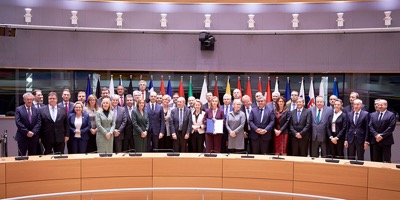The establishment of PESCO makes absolutely clear the plan for “a Europe
for Defense”. In any event, PESCO has limited potential. Sure, a
sovereign entity has come onto the scene, but it’s one that can’t
compete with Nato, but can only complement it. In principle, the next stage
should position this “Europe for Defense” so that France controls its
nuclear force and Germany controls its conventional force. Any part of
PESCO can only be harnessed if the Pentagon gives the order. And this green
light will only come on when the US’s military objectives need to be
sub-contracted.

After a 60 year gestation period, Roberta Pinotti, the Defense Minister announces that “PESCO” is on the verge of being born in December. PESCO is a EU “Permanent Structured Cooperation” in the military sector. To start with, 23 of the 27 EU member states are participating in it.
Jens Stoltenberg, Nato’s Secretary General, explains what this cooperation might entail. Participating in the EU’s Council for Foreign Affairs, he emphasizes, “the importance, evidenced by so many European leaders, of European Defense needing to be developed so that it does not compete with Nato, but rather complements it”.
The first way of achieving this is for each European member state to increase its individual military expenditure. PESCO establishes that one of the “joint ambitious and rather onerous undertakings” is “the periodic increase in real terms of the defense balance sheets in order to reach the agreed objectives”. 21 of the 27 EU member states are Nato members. Nato’s continuously increasing budget now has the additional expenditure of the European Defense Fund through which the EU will earmark 1.5 billion euro per year to finance research projects in military technology and to buy shared arms systems.
This will be the base line figure, destined to increase over the years. On top of PESCO, are additional costs for “developing new capabilities and preparing to participate together in military operations”. “Capabilities complementing Nato requirements”: on 8 November 2017, Nato’s North Atlantic Council resolved to adapt the command structure so that, “the capacity to strengthen the Allies quickly and effectively” in Europe would be increased.
For this purpose, two new commands are established. A Command for the Atlantic, with the mandate of maintaining “free and secure maritime lines of communication between Europe and the United States, vital for our Transatlantic Alliance”. A Command for Mobilization, tasked with “improving Nato military forces’ capability to move through Europe”.
To enable forces and arms to be moved rapidly on European territory, the Nato Secretary General explains that European countries must “remove many bureaucratic obstacles”. Much has been done since 2014, but there is still a lot of work that needs doing so that “national laws that facilitate military forces passing across borders are fully applied”. Moreover Stoltenberg adds that Nato needs to have available in Europe, sufficient capability to transport soldiers and arms, largely provided by the private sector.
It is even more important for Europe’s “civil infrastructure – such as roads, bridges, railways, airports and ports to be improved– so that they are adapted to Nato’s military requirements”. In other words, European countries must carry out, at their own expense, works to make the civil infrastructure fit for their military use: for example a bridge that is fit for the traffic of trams and lorries will have to be strengthened to allow tanks to pass.
This is the strategy that PESCO forms part. This strategy is the expression of dominant European interests that, while colliding with US interests, then realign themselves in harmony with them, within a Nato under US Command. This occurs whenever the fundamental interests of the West endangered by a world that is changing, are at stake. So when the “Russian Threat” kicks off, it will be confronted by a “United Europe”, which, while slashing its welfare expenditure and blocking off its internal borders to migrants, balloons its military expenditure and dismantles its internal borders when it comes to soldiers and tanks, so that they can roam about freely within.

 Articles by this author
Articles by this author Send a message
Send a message






















Stay In Touch
Follow us on social networks
Subscribe to weekly newsletter